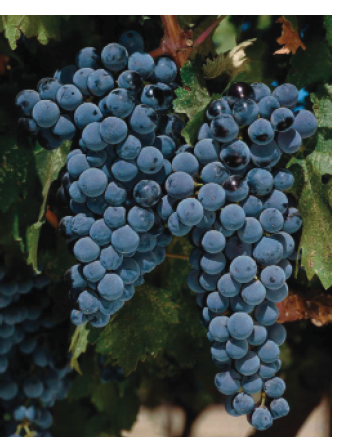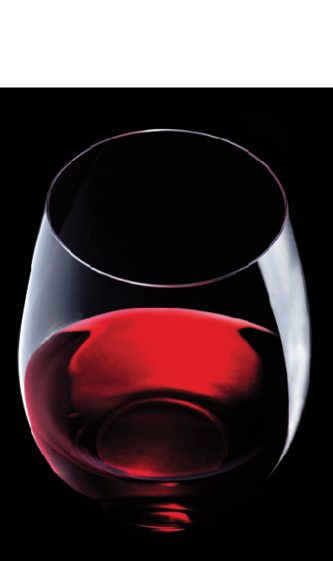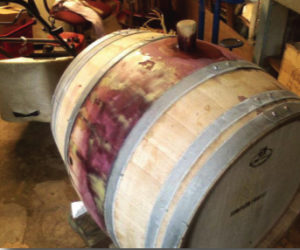 Not everyone is looking for elegance and restraint in their red wines. It’s easy for those who make a more transparent and light style of wine to become jaded and stylistically fixated. Those who like a lighter wine generally think those that like the big reds are missing something. But are they?
Not everyone is looking for elegance and restraint in their red wines. It’s easy for those who make a more transparent and light style of wine to become jaded and stylistically fixated. Those who like a lighter wine generally think those that like the big reds are missing something. But are they?
WineOption.org recently published a study that showed a fairly even split between two kinds of wine drinkers and their drinking habits: those that use wine with food, and those that consume it as a cocktail outside of mealtime. This was a big surprise for many of us in the wine business. If nearly half of all fine wine is being consumed without food, this was further evidence that the popularity of big, ripe, soft, juicy, even slightly sweet red wines is here to stay and they will continue to enjoy brisk sales. If you haven’t read the trade mags: inexpensive, slightly sweet red wine is huge in the market right now. Sweet red will be making big inroads in 2012.
Full disclosure: this study shocked me into a slightly new way of thinking about wine. I’ve always believed that wine was a mealtime beverage — and as such should respect the flavors of food by showing some restraint and transparency. I believed wine and food should meet halfway — light wines with light foods (a Sauvignon Blanc with a Morro Bay oyster), or a heavier wine with heavier foods (Napa Cabernet with a steak au poivre). But if wine is being drunk alone, the wine has to match itself, offer a full flavor experience by virtue of its craft.
So I call these wines “stand up” wines. Big, rich, ripe, darkly-colored red wines are a great beverage while standing at a cocktail party, an office soirée or even at a bar or club. They fill the mouth with flavor and offer a good deal of alcohol by volume. They are impressive in their peer group, garnering higher point scores, and are popular at festival-style wine tastings.
So let’s define what a “big red” is and then we’ll figure out how to put a little extra Sine Qua Non or Screaming Eagle-style into your backyard vineyard.
What is a “big red?”
Tim Patterson details some pretty good guidelines for big reds in this article. And when I think of a “big red” outside the context of the cinnamon chewing gum my wife loves, I think of:
1. Wines between 14.7–18.5% ABV. Think 18.5% is ridiculous? There are non-fortified wines on shelves right now from the Barossa, Australia with 18.5% alcohol. Why 14.7? That is my personal, perhaps somewhat arbitrary, number for a ripe wine. A wine can be hot at 14.3, or balanced at 16.5% I’m not making value or craft judgments, just defining what I perceive is ripeness in red wine.
2. pH above 3.5, but hopefully under 4.0. TA is a little trickier, but I would shoot for about 6 g/l, but can vary between 5-9 under most circumstances.
3. The wine is not meant to become profound with age, but instead impresses with gobs of ripe, dense, youthful fruit, extraction, attack, glycerin and tannin.
4. In the mouth the wine is generous, soft, rich and warm. It may finish with alcohol heat balanced by acidity, oak and tannin.
5. The wine is more of an expression of winemaker affectation vis a vis picking at high ripeness, than an attempt to capture the essence of a vintage or a vineyard. One could argue that making a big, ripe wine is an expression of a special vineyard, but I would argue the vintage and place would be more transparent at lower Brix levels. (Please note I am editorializing here.)
“Big” in your backyard
Armed with our new definition of “big reds,” let’s see what we can do in the vineyard to kick the extract up a notch. Do you have the climate and soil for big reds? It would be easy to believe that color and extract comes from hot climates, but color comes from cool. While it’s true that sunlight is the fuel for a vine to produce sugar and phenolic/polyphenolic compounds, big color and flavor are actually products of vines grown on the edge of where they cannot get ripe.
Read that last paragraph again, because I can’t stress how important it is to our discussion. Color and flavor come from cool, not heat. Let me explain. If a vine soaks up the inland San Joaquin heat (UC-Davis Zone 5), the vines grow swiftly and vigorously, and the fruit ripens very quickly. In the cool, coastal (Zone 1) Santa Rita Hills, it takes June-October to accumulate the degree days that Fresno could accumulate in July alone. So the ripeness is extended and delayed, allowing the fruit to hang and hang in the cool fog, the afternoon breezes and the coastal sunshine. Pinot Noir would be harvested in July in San Joaquin, but can hang until late October in the Santa Rita Hills. The San Joaquin Pinot would look like light rosé, and the Santa Rita Hills stuff often looks Syrah-like. This is an expression of one of the coolest, longest hang-times in all of the wine world.
But what about Cabernet, Norton, Zinfandel? Don’t they need the heat? Absolutely. And the higher in latitude you grow grapes, the more dependent you are on a hot summer to get the ripeness you need. In California, we want to extend hang time because we know we’ll get the sun and will likely stay dry through October. But in the Upper Penninsula of Michigan, you may struggle to get Riesling over 20 °Brix in a cool summer. Warm climate grapes like Cabernet or Zinfandel require more degree-day accumulation to ripen, so how are they affected by the “color comes from cool” theory?
Wes’ two truisms of ripeness
1. The finest wines in the world are grown on the edge of where they can get ripe.
2. The biggest/richest wines in the world are grown in areas with abundant sunshine, limited summer rain, and the capacity to hang on the vine to an exaggerated level of ripeness.
An example of the first type of climate would be Burgundy, France. Cold winters and hot summers truncate the growing season. In a ripe year, the wines are glorious and rich, in a cool year they can be insipid and green. An example of the second type of climate would be the Barossa Valley in Australia or the Napa Valley in California. Arid temperatures, deficit irrigation, modern trellising, clonal selection and rain-free harvest periods can produce intensely ripe grapes bursting with color and flavor compounds. These grapes can produce wines of such density and impact that they can impress even those whose palates were weaned on Big Macs and milkshakes.
What grape to choose for color and flavor?
Of course, this really depends on where you live. You may not be able to reproduce the opaque, dense nature of California Cabernet in the Midwest or East Coast. With all the home vineyards going in all over the world (I’m so proud of all you!), you have more resources than any other small production grower in the history of grape growing.
To discover which grape makes the best big red in your neighborhood, you really need to get out and meet local home winemakers, taste a bunch of wines, experiment, and realize it may be generations before we find the right varietals to match your home-town terroir. Experiment! Make some bad wine! Have some fun! Make some sangria if you have to.
Don’t punt with Cabernet! I always say that I prefer Missouri Norton to Missouri Cabernet. It’s not even close. I have put bagged Norton on a table at a blind Cab tasting and the wines have overachieved — scoring higher than half the California Cabs on the counter. Hybrid vines are nothing to be ashamed of — they are more American than any Euro vinifera, and I do believe hybrid and native growers are the only Americans really experimenting with terroir. How can you talk about the relationship of a vine and the environment when the vines are taken from Europe and inserted into our dirt?
Syrah gives more color than Grenache, and adapts to a lot of climates, so that may be a good choice. Nebbiolo, Dolcetto, Marechal Foch, Norton, Petit Sirah, Lagrein, Nero d’Avola, and many other grapes can produce big, red wines in warm to hot regions. Growing in cold climate? Try Dornfelder. You won’t believe the color and aroma. Get out there and find out what’s happening in your backyard, in your region, in your state or province and then put some vines in the ground. Viticulture is like golf. You’re not going to shoot par your first time out. It’s humbling and it can spoil a walk.
Quick winemaking tips
• Bleed off 10% of the juice from your red ferment one day after crushing and make some rosé. The remaining 90% will gain more color and extract as a result. If your wine is tannic without a bleed-off, do not remove juice. If the wine is still light, try 20% bleed off the subsequent year.
• Remember that higher pH wines are less stable and require much more SO2 to stay happy and sound in barrel or (especially) carboy.
Vineyard tips
What if you already have a vineyard planted? Let’s see what we can do in the field to increase color and impact.
Pruning: Intensity can be improved by lowering yields on low and moderate/low vigor vineyards. Remove more of last year’s growth, prune to 1 bud or 2 bud spurs and eliminate “kicker” canes. Do not prune this way on high vigor vineyards. Lowering yield on high vigor vines may actually lower quality.
Thinning: Remove unfruitful/double shoots and reduce crop level if necessary by shoot thinning at 6-inch (15-cm) shoot growth, when you can see clearly the amount of crop present.
Canopy: Sun flecking/exposure without burning the fruit will encourage flavor, phenolic and anthocyanin production – all which will combine to make darker and richer wines in the vineyard. Do not overexpose the fruit, but attempt to bathe it in morning and afternoon sun — keep upper leaves to protect it from sunlight from 11 am to 1 pm.
Water: Deficit irrigation can stress a vine at the right time to encourage flavor and color development. Keep the vine healthy and growing, but start letting the soil dry out completely between waterings when you want to see ripeness accelerate.
Harvest: Get it ripe, harvest at night if you can. As long as flavor is increasing and the weather looks good, let it hang! If pH starts climbing to the 3.8 range, unless the TA is sky high, plan on picking. Hang time is key for flavor and sugar, so if you can get 28 °Brix and still have sound fruit, that will make a big red! Try watering back ripe must to 24.5 °Brix, but if you want it really big, crank it to 25.5. The wine will still be dense and ripe, but the alcohol will be in check. Adding 20 g of tartaric acid per gallon (5g/L) of water will keep the pH fairly stable.
Chasing the big red
The quest for the big red is as old as time itself. As Dr. Patrick McGovern points out in his book Uncorking the Past, European grape wine is given such reverence by humans because it makes the strongest booze in nature. It could be argued that making big, high alcohol wines is the evolutionary destiny of human beings, and when we make these types of wines we are just testing the limits of the yeast’s biology and our liver’s tenacity.
“
“
Those who like a lighter wine generally think those that like the big reds are missing something. But are they?








